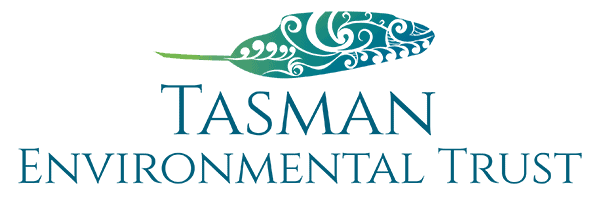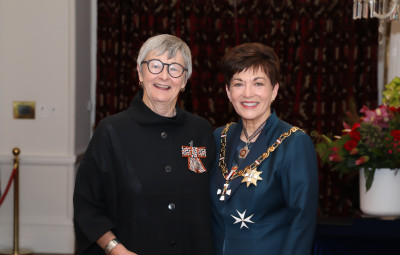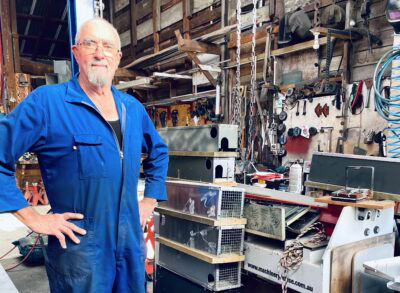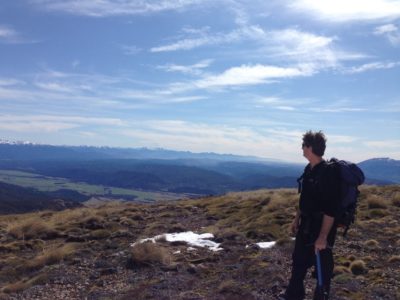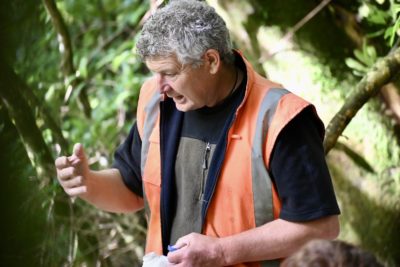Over the last 20 years, TET’s chair Gillian Bishop has been a Waimeha/Waimea Inlet conservation pioneer and force of nature. Her achievements were recognised in 2020 with the Queen’s Service Medal.
We asked Gillian to share her story as our inaugural Conservation Hero.
What’s your background?
My career has been in the health sector in management and in the development of new contracts, and putting them in place in different health agencies—so developing new arrangements with people that want to work together and making those arrangements work.
When I finished doing that, about the year 2000, we came over to Nelson to live; I’d been living in Wellington, my husband and I, and the family. We bought a property on the edge of the Waimea Inlet and built a house and started the next phase of life.
Why did you then decide to focus on conservation?
The Waimea Inlet is beautiful and I could see there was quite a lot going on around it, developments—industrial, a lot of housing—and it wasn’t clear to me who was engaged with protecting it and giving it a voice.
So I started making some inquiries. And fortunately, at that time, Nelson City Council and Tasman District Council had engaged a consultant, Glen Lauder, to develop a management strategy for the Waimea Inlet. So I made contact with Glen and started to work with him on the Waimea Inlet Management Strategy, and it basically goes from there.
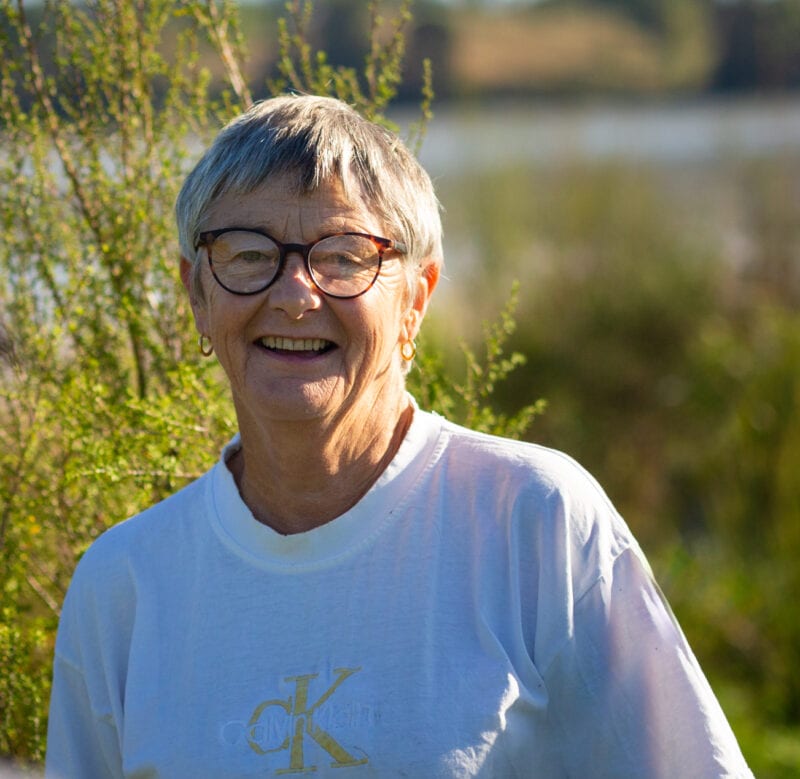
So you had no prior experience in conservation and just decided to jump right in anyway?
Yes. I had to google “biodiversity”. I didn’t know what it meant!
I felt that we needed to look after [the Inlet] for future generations. It’s hard to say that without sounding cliched, but I have a big family and I’ve had some wonderful experiences in my life on the seashore and in wild places, and I think that’s something that we have to work hard to protect.
So there was a bit of that, wondering to protect our wild places—the beauty and the stillness—and also to just make improvements.
Have you noticed anything changing in conservation over the last 20 years?
Dramatic changes, yes.
One of Glen Lauder’s principles is community empowerment. And I’d been working in government in a fairly bureaucratic model, and the community empowerment principle completely flipped that over.
It said you don’t have to wait for somebody else to tell you what to do, or to tell you how important something is. If you love it, and you want to protect it, you can do that. You can make change from a community level.
So out of the Waimea Inlet Management Strategy, the Waimea Inlet Forum was created. It’s a community group that provides information to the community, but also gives the community influence in terms of local councils and other people around the Inlet. That was established back in 2010.
What other changes have you seen?
Back in the beginning, biodiversity was a technical term used by a few people. Now, it’s in common parlance, isn’t it? Climate change was being talked about in the year 2000 but it’s top of mind now. Everybody is aware of the impact of climate change.
I think a lot of people are keen to do something themselves.
Everybody’s got their own take on what’s important, what they can do, but I’m sure it contributes to people’s willingness to go out and plant and track predators.
There’s a lot more opportunity to get involved now. Predator Free New Zealand’s spreading the word about the importance of reducing the number of predators. Nationally, care of the environment is a lot more common in everybody’s thinking than it was 20 years ago.
How have conservation groups and their operations changed?
That’s probably a good segue into how I got involved with TET. I was, I suppose, leading the Waimea Inlet Forum. And we wanted to start a project around the margins of the Waimea Inlet to protect and enhance habitat.
Then DOC started a new grant called the DOC Community Partnerships Fund and we thought, Oh, well, we’ll apply for some funding from that. So we put together a project called Battle for the Banded Rail, which was for habitat restoration, predator control and project management, and we submitted an application to DOC.
In order to receive the funding, you had to be an incorporated society or have a formal structure—and we didn’t. That was one of the things about the Waimea Inlet Forum: it was quite informal. So I wrote to Tasman Environmental Trust and said, “Could we come under your umbrella?” And they said yes. That was the start of TET working with community groups—around 2012.
We got some funding. And then, after a while, TET asked me if I would like to become a trustee, which I did. And it went from there, really.
TET at that stage was relatively small but it’s steadily grown from that point on. And that required the development of a lot of systems and processes.
We realised that they’re the kind of things that fit you for receiving funding from outside organisations but it’s quite arduous for a community group to do all the back office stuff, and there was a good opportunity to offer our services to other community groups.
So there are now quite a few community groups and some large projects that we’re managing but they’ve all got an emphasis on community engagement and volunteer involvement.
What’s been your biggest personal success in the last 20 years?
That’s a tricky question, because the successes are at various levels but I’d have to say the work around the Waimea Inlet. I just take immense pride in that.
I’m really proud that last planting season there was an average of 50 volunteers turn up for planting days. There’s now active weeding groups… and success at a variety of levels in terms of submissions to Council, volunteer enrolment and predator control.
All around the Waimea Inlet there are hundreds of people with an interest in, and actively contributing to, its future, so yeah, I’m really proud of it.
I’m also proud of where Tasman Environmental Trust is now. I think that we’ve got a wonderful team. Our voice is being heard now and community groups realise how, by joining together, they can be supported in the work that they want to do without being taken over.
Project Mōhua in Golden Bay is a really good example of that. They were already established as a sort of a community forum but they wanted to go further. They wanted to become an incorporated society and attract more funding. They looked at setting up themselves and then realised even getting established was going to take more of their energy than they were really prepared to devote to that sort of stuff. They wanted to do on-the-ground work, not office work.
So they started talking with TET. It took a little while to establish trust but they’re now a highly effective group with a good bunch of people on the management team and a strategic plan. They’re out there doing stuff now and they’re working well with TET. So, yes, that’s a good example of how support can help groups get ahead.
What’s been your biggest challenge?
I think the concept of a community conservation hub is great and it’s one that’s supported nationally by a variety of organisations at government level, and elsewhere. But we struggle for funding.
Our funding comes in one-year blocks. We have to shepherd our resources very carefully.
We do a lot on a little, and a lot of our energy is directed to trying to attract funding to keep us going… and it’s very frustrating because our time would be much better spent actually getting out there and going forward, rather than just trying to sustain ourselves.
An example of going forward and what’s just starting to bear fruit is that we’re really trying to strengthen our relationships with iwi. Last year we created three iwi representative positions on TET’s board. They’re currently vacant but we know it’ll happen when the timing’s right and we have the projects and relationships in place. That’s starting to occur now.
This year you were awarded the Queen’s Service Medal for your services to conservation in New Zealand. What was that like?
Oh, well, it was wonderful. Yeah, it was wonderful! I honestly did feel honoured. And I thought it really acknowledges the work of the team at TET and where we’ve got to there. I know that the Waimea Inlet community involvement is something that’s recognised nationally, so I felt that that was also something that was being acknowledged.
It’s very special. All my family came to Wellington for the investiture ceremony. And it was really humbling to be amongst the other people at the ceremony and part of the whole occasion. It was great.
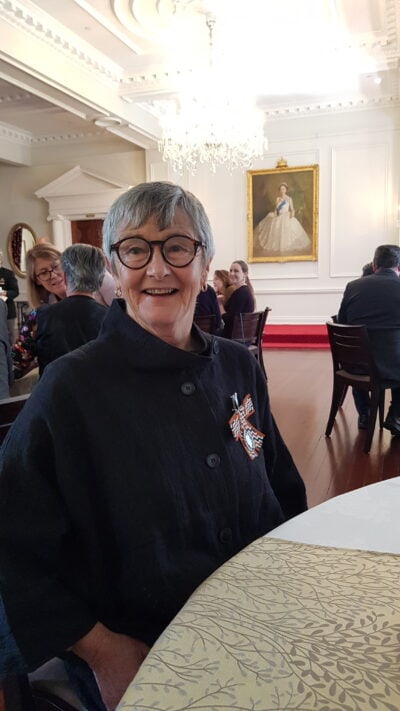
What are your thoughts about the next five years in conservation?
The younger generation are providing really valuable energy and drive for change but “the ball is in all of our courts”. No-one and no generation can absolve themselves of responsibility to make changes to protect the environment and reduce the impact of climate change.
So that gives hope. I think community empowerment is a lot more prevalent. People recognise now that it’s not up to somebody else to make the changes that are required—everybody needs to take responsibility in one way or another.
At different times in your life you’re busy doing stuff, and just keeping alive and keeping the show on the road. But then there are times in your life when you do have a space and you can poke your head above the parapet and see what’s out there. I think there’s a lot of opportunity now for people to contribute to environmental or conservation work. You know, even just a little bit, every now and again, and it all contributes.
I think there are some big problems that are going to need to be solved. So hopefully, community groups and councils and government can find kinder ways of treating the world.
